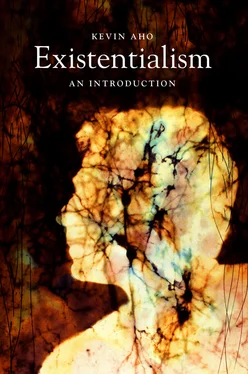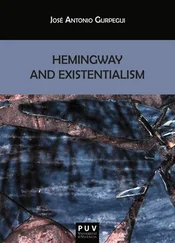Kevin Aho - Existentialism - An Introduction
Здесь есть возможность читать онлайн «Kevin Aho - Existentialism - An Introduction» весь текст электронной книги совершенно бесплатно (целиком полную версию без сокращений). В некоторых случаях можно слушать аудио, скачать через торрент в формате fb2 и присутствует краткое содержание. Год выпуска: 2013, ISBN: 2013, Издательство: Polity, Жанр: Философия, на английском языке. Описание произведения, (предисловие) а так же отзывы посетителей доступны на портале библиотеки ЛибКат.
- Название:Existentialism: An Introduction
- Автор:
- Издательство:Polity
- Жанр:
- Год:2013
- ISBN:978-0745651422
- Рейтинг книги:3 / 5. Голосов: 1
-
Избранное:Добавить в избранное
- Отзывы:
-
Ваша оценка:
- 60
- 1
- 2
- 3
- 4
- 5
Existentialism: An Introduction: краткое содержание, описание и аннотация
Предлагаем к чтению аннотацию, описание, краткое содержание или предисловие (зависит от того, что написал сам автор книги «Existentialism: An Introduction»). Если вы не нашли необходимую информацию о книге — напишите в комментариях, мы постараемся отыскать её.
Existentialism: An Introduction
Existentialism: An Introduction — читать онлайн бесплатно полную книгу (весь текст) целиком
Ниже представлен текст книги, разбитый по страницам. Система сохранения места последней прочитанной страницы, позволяет с удобством читать онлайн бесплатно книгу «Existentialism: An Introduction», без необходимости каждый раз заново искать на чём Вы остановились. Поставьте закладку, и сможете в любой момент перейти на страницу, на которой закончили чтение.
Интервал:
Закладка:
Modern psychology and the medical specialty of psychiatry emerged against the backdrop of the scientific revolution in the seventeenth century and developed into their own distinct disciplines in the late nineteenth and early twentieth centuries. Informed by the perspective of natural science, psychologists and psychiatrists tend to view the patient from a particular paradigm. First, because scientists adhere to a technical procedure or ‘method’ based on the subject-object model, the patient is usually regarded dispassionately as an object of investigation, and emotional and behavioral dysfunctions are viewed as discrete entities that are, like all other things in the natural world, the result of mechanistic causal interactions that can be quantified and controlled. Second, by taking a position of methodological detachment, little effort is made to contextualize the patient's experience, to understand his or her life-world. The therapist views the patient through the lens of a set of fixed determinations, restricted to the objectively observable behavior and looking for the causal mechanisms of disease (Laing 1960, 31–33). Although Freud and a number of different psychoanalytic models certainly recognize the importance of inter-human relations, they still abide largely by a mechanistic conception of human behavior and the techniques of objectification that, in the words of Heidegger, “transfer scientific causality to the psychical” (2001, 20). Psychoanalysis, as Freud confirms, “must accept the scientific Weltanschauung. … The intellect and the mind are objects for scientific research in exactly the same way as non-human things” (Freud 1964, 171; cited in Askey 2001, 309).
To be sure, the attitude of scientific detachment allows the therapist to maintain a position of alleged neutrality and objectivity and also serves as a buffer of self-protection from the exposure and vulnerability that can manifest in the therapeutic encounter. But in defending from this emotional threat, the therapist is often cut off and dissociated from the patient, making it difficult to recognize him or her as a person . “If the technical view is used dominantly in the relating to the other person,” writes existential therapist Rollo May, “the price [is] not only the isolation of himself from the other but also of radical distortion of reality [because] one does not really see the other person” (1958b, 39). R. D. Laing will go so far as to suggest that psychiatry's reduction of the human being to a complex organism and its failure to situate the patient in his or her life-world is not only dehumanizing; it's pathological. “[Psychiatry is] concerned specifically with people who experience themselves as automata, as robots, as bits of machinery,” he writes. “Yet why do we not regard a theory that seeks to transmute persons into automata or animals as equally crazy?” (1960, 23). Against the mechanistic account, existential therapists suggest that the primary aim of treatment is to relate to the patient's own lived situation. The therapist, says Laing, “must have the plasticity to transpose himself into another strange and even alien view of the world … without forgoing his sanity. Only thus can he arrive at an understanding of the patient's existential position ” (34).
As we have seen, existentialists interpret human beings not in terms of psychosomatic mechanisms but in terms of existence , that is, in terms of the situated activity or way of being that is already bound up in a world. On this view, we understand ourselves only in relation to our involvement with others and the shared meanings of the public world. Thus, in order to relate to the patient, the therapist must first relate to the patient's way of being-in-the-world. Swiss psychiatrist Ludwig Binswanger describes the therapeutic aim as one that does not try to ‘explain’ the causal mechanisms of a disorder or divide the patient into distinct categories of mental and physical but, rather, attempts to ‘understand’ the patient by entering into his or her life-world.
A psychotherapy on existential-analytic bases investigates the life-history of the patient to be treated, … but it does not explain this life-history and its pathologic idiosyncrasies according to the teachings of any school of psychotherapy, or by means of its preferred categories. Instead, it understands this life-history as modification of the total structure of the patient's being-in-the-world. (1956, 145)
From the existential perspective, understanding the patient has nothing to do with a scientific explanation of the causes of emotional or behavioral dysfunction. Accumulating data on hereditary or familial incidence, assessing speech or behavioral abnormalities, measuring heart rate, and examining brain scans do not help us relate to the patient's experience. The existential therapist recognizes that in coming into treatment, the patient does not just bring in a set of observable psychosomatic symptoms. He or she brings an entire existential situation, with all of the regrets, fears, traumas, and desires that accompany this existence. By attempting “to articulate what the other's world is and his [or her] way of being in it” (Laing, 1960, 25), the therapeutic encounter opens up the possibility of understanding of ‘ what it means ’ and ‘ what it feels like ’ for this particular person to suffer. Bracketing out scientific assumptions in this way, the existential therapist is able to gain insight into the patient's being, not as a diseased thing, but as an embodied existence whose pre-reflective bond with the world has been profoundly disrupted.
Anxiety, embodiment, and psychotherapy
As we saw earlier, the human body shows up differently for existentialists. It is not a causally determined physical body but a ‘lived body,’ where this is understood as the first-person experiences, feelings, and perceptions of my own body. The body, in this sense, is not a discrete object that I can examine from a perspective of scientific detachment because I am already living through it; it already belongs to me. “What I feel,” writes Marcel, “is indissolubly linked to the fact that my body is my body , not just one body among others. … Nobody who is not inside my skin can know what I feel ” (1950, 104). But, from the perspective of being-in-the-world, it is a mistake to think that these feelings reside somewhere inside me as if I were a self-contained subject. As Heidegger says, “There is no longer any question about subjectivity. [Being-in-the-world] is not the ‘structure of subjectivity,’ but its abolition ” (1988, 220). To be sure, my feelings are mine, but as a situated and embodied way of being, there is no clear distinction between ‘inner’ and ‘outer,’ because my emotional life is already embedded in shared contexts of meaning. Indeed, it is only on the basis of being bound up in these public contexts that I can find myself in moods — in situations that emotionally affect me in particular ways. As someone absorbed in the meanings of the academic world, for instance, things like books, classrooms, and lectures already matter to me in a way that is fundamentally different from a salesman, a banker, or anyone else unfamiliar with this world. In this way, the moods of the academy are always working behind my back to orient me in the world, already directing me toward the things that matter and providing a background sense of what counts in specific situations. They are, as Heidegger writes, “like an atmosphere in which we first immerse ourselves in each case and which then attunes us through and through” (1995, 67, my emphasis).
When I am mentally healthy, I am integrated and woven into the world to such an extent that my body and my feelings remain largely hidden from me. They disappear in the practical flow of my daily life because I am already geared to my situation, seamlessly living through the medium of my body without explicitly reflecting on it. In this state of everydayness, there is no separation between self and world; the world appears spontaneously to me as something that I understand, that I belong to, and am ‘at home’ in. It shows up as real, secure, and reliable, and others show up for me as equally real, secure, and reliable. In this state, I have what Laing calls “ontological security” (1960, 39, 42). Secure in my being, I can pre-reflectively move through the world, handle various situations, and affectively involve myself in the lives of others. From the perspective of existential therapy, psychopathology begins to emerge when this embodied connection breaks down, shattering my sense of self. Without the unified bond of being-in-the-world to integrate and hold my identity together, I feel as if I am losing myself, as if I am becoming nothing. Existentialists usually refer to this uncanny dissolution of the self in terms of ‘anxiety’ or Angst .
Читать дальшеИнтервал:
Закладка:
Похожие книги на «Existentialism: An Introduction»
Представляем Вашему вниманию похожие книги на «Existentialism: An Introduction» списком для выбора. Мы отобрали схожую по названию и смыслу литературу в надежде предоставить читателям больше вариантов отыскать новые, интересные, ещё непрочитанные произведения.
Обсуждение, отзывы о книге «Existentialism: An Introduction» и просто собственные мнения читателей. Оставьте ваши комментарии, напишите, что Вы думаете о произведении, его смысле или главных героях. Укажите что конкретно понравилось, а что нет, и почему Вы так считаете.












